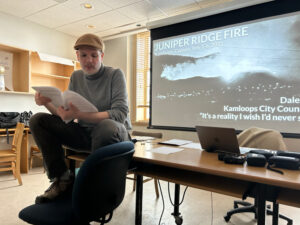The effects of climate change are becoming all too familiar to Nova Scotians. From fires to floods, the dangers of a warming planet are beginning to reveal themselves. But Nova Scotians are resilient; community bonds are a source of hope.
As journalists, we tend to operate beyond the purview of the communities we serve. We hold stories at a distance. We do not engage in the action. We observe, we describe, we inform. However, maintaining distance in environmental journalism is impossible when we are all implicated. Climate change affects everyone–including journalists.
 The Climate Disaster Project bridges the gap between journalists and citizens. Professor Sean Holman, the Wayne Crookes Professor of Environmental and Climate Journalism at the University of Victoria, has created an interesting new methodology for climate reporting. Developed in partnership with various experts and experienced journalists, Prof. Holman’s Climate Disaster Project employs a trauma-informed, empathetic approach to storytelling.
The Climate Disaster Project bridges the gap between journalists and citizens. Professor Sean Holman, the Wayne Crookes Professor of Environmental and Climate Journalism at the University of Victoria, has created an interesting new methodology for climate reporting. Developed in partnership with various experts and experienced journalists, Prof. Holman’s Climate Disaster Project employs a trauma-informed, empathetic approach to storytelling.
The Advanced News Workshop operates like a newsroom for the Climate Disaster Project. Students are journalists who will help tell stories of our communities’ experiences with climate disasters. Prof. Holman and Rogers Chair in Journalism Lisa Taylor serve as editors and instructors for the project. During the first week of the workshop, Prof. Holman joined us in person to train us in his methodology.
Climate disasters can be traumatic. Those who go through them may experience long-lasting emotional effects. Journalists have a responsibility to report on the impact of climate change on society, but interviewing climate disaster survivors needs to be done thoughtfully. We do not want to further harm or trigger survivors while they tell us their stories. This is why we employ what Prof. Holman calls “empathetic interviewing.”
The goal is to level the playing field. Interviewees are provided equal, if not greater, control over the story being told. Survivors are credited as co-authors and entitled to edit their narratives as they see fit. After all, these are their stories.
This is a unique and crucial form of journalism. It acknowledges the power imbalance between the interviewer and interviewee. It acknowledges that reporting on disaster can take an emotional toll on journalists, which is why we have learned about trauma psychology and self-care.
Beyond the first week of training, Prof. Holman continues to engage in the workshop as an instructor and editor. It is a privilege to participate in this project and learn his methods.
The Climate Disaster Project provides journalists and survivors with a sense of community. Climate disasters don’t occur in a vacuum; they are experienced all over the world. By sharing the experiences of our province, we raise awareness for all the work that is yet to be done to save our planet.

